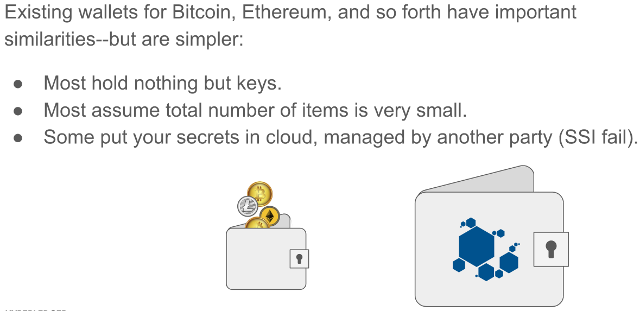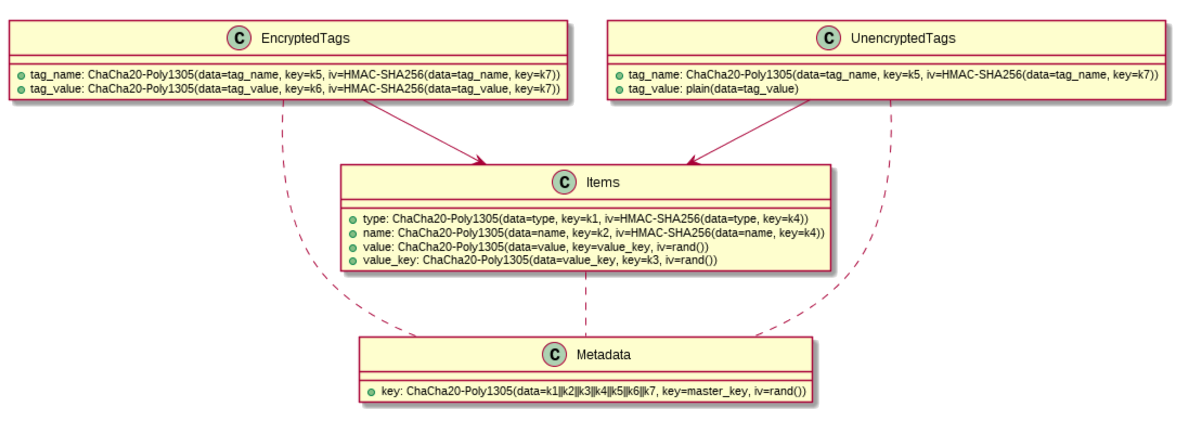New location: aries-rfcs/concepts/0050-wallets
0013: Wallets¶
Author: Daniel Hardman, Darko Kulic, Vyacheslav Gudkov, Mike Lodder
Start Date: 2018-05-22
Status¶
Status: SUPERSEDED
Status Date: (date of first submission or last status change)
Status Note: (explanation of current status; if adopted, links to impls or derivative ideas; if superseded, link to replacement)
Summary¶
Specify the external interfaces of identity wallets in the Indy ecosystem, as well as some background concepts, theory, tradeoffs, and internal implementation guidelines.

Motivation¶
Wallets are a familiar component metaphor that SSI has adopted from the world of cryptocurrencies. The translation isn’t perfect, though; crypto wallets have only a subset of the features that an identity wallet needs. This causes problems, as coders may approach wallets in Indy with assumptions that are more narrow than our actual design target.
Since wallets are a major vector for hacking and cybersecurity issues, casual or fuzzy wallet requirements are a recipe for frustration or disaster. Divergent and substandard implementations could undermine security more broadly. This argues for as much design guidance and implementation help as possible.
Wallets are also a unit of identity portability–if an identity owner doesn’t like how her software is working, she should be able to exercise her self- sovereignty by taking the contents of her wallet to a new service. This implies that wallets need certain types of interoperability in the ecosystem, if they are to avoid vendor lock-in.
All of these reasons–to clarify design scope, to provide uniform high security, and to guarantee interop–suggest that we need a formal HIPE to document wallet architecture.
Tutorial¶
(For a slide deck that gives a simplified overview of all the content in this HIPE, please see http://bit.ly/2JUcIiT. The deck also includes a link to a recorded presentation, if you prefer something verbal and interactive.)
What Is an Identity Wallet?¶
Informally, an identity wallet (preferably not just “wallet”) is a digital container for data that’s needed to control a self-sovereign identity. We borrow this metaphor from physical wallets:

Notice that we do not carry around in a physical wallet every document, key, card, photo, piece of currency, or credential that we possess. A wallet is a mechanism of convenient control, not an exhaustive repository. A wallet is portable. A wallet is worth safeguarding. Good wallets are organized so we can find things easily. A wallet has a physical location.
What does suggest about identity wallets?
Types of Sovereign Data¶
Before we give a definitive answer to that question, let’s take a detour for a moment to consider digital data. Actors in a self-sovereign identity ecosystem may own or control many different types of data:
encryption and signing keys
payment keys
link secrets
PII about themselves or others
credentials
personal documents (e.g., last year’s tax filing, journal, love letters)
digital breadcrumbs (e.g., purchase history)
photos and videos
receipts
health records
…and much more. Different subsets of data may be worthy of different protection efforts:

The data can also show huge variety in its size and in its richness:

Because of the sensitivity difference, the size and richness difference, joint ownership, and different needs for access in different circumstances, we may store digital data in many different locations, with different backup regimes, different levels of security, and different cost profiles.
What’s Out of Scope¶
Not a Vault¶
This variety suggests that an identity wallet as a loose grab-bag of all our digital “stuff” will give us a poor design. We won’t be able to make good tradeoffs that satisfy everybody; some will want rigorous, optimized search; others will want to minimize storage footprint; others will be concerned about maximizing security.
We reserve the term vault to refer to the complex collection of all an identity owner’s data:

Note that a vault can contain an identity wallet. A vault is an important construct, and we may want to formalize its interface. But that is not the subject of this spec.
Not A Cryptocurrency Wallet¶
The cryptocurrency community has popularized the term “wallet”–and because identity wallets share with crypto wallets both high-tech crypto and a need to store secrets, it is tempting to equate these two concepts. However, an identity wallet can hold more than just cryptocurrency keys, just as a physical wallet can hold more than paper currency. Also, identity wallets may need to manage hundreds of millions of relationships (in the case of large organizations), whereas most crypto wallets manage a small number of keys:

Not a GUI¶
As used in this spec, an identity wallet is not a visible application, but rather a data store. Although user interfaces (superb ones!) can and should be layered on top of wallets, from indy’s perspective the wallet itself consists of a container and its data; its friendly face is a separate construct. We may casually refer to an application as a “wallet”, but what we really mean is that the application provides an interface to the underlying wallet.
This is important because if a user changes which app manages his identity, he should be able to retain the wallet data itself. We are aiming for a better portability story than browsers offer (where if you change browsers, you may be able to export+import your bookmarks, but you have to rebuild all sessions and logins from scratch).
Personas¶
Wallets have many stakeholders. However, three categories of wallet users are especially impactful on design decisions, so we define a persona for each.
Alice (individual identity owner)¶

Alice owns several devices, and she has an agent in the cloud. She has a thousand relationships–some with institutions, some with other people. She has a couple hundred credentials. She owns three different types of cryptocurrency. She doesn’t issue or revoke credentials–she just uses them. She receives proofs from other entities (people and orgs). Her main tool for exercising a self-sovereign identity is an app on a mobile device.
Faber (intitutional identity owner)¶

Faber College has an on-prem data center as well as many resources and processes in public and private clouds. It has relationships with a million students, alumni, staff, former staff, applicants, business partners, suppliers, and so forth. Faber issues credentials and must manage their revocation. Faber may use crypto tokens to sell and buy credentials and proofs.
The Org Book (trust hub)¶

The Org Book holds credentials (business licenses, articles of incorporation, health permits, etc) issued by various government agencies, about millions of other business entities. It needs to index and search credentials quickly. Its data is public. It serves as a reference for many relying parties–thus its trust hub role.
Use Cases¶
The specific uses cases for an identity wallet are too numerous to fully list, but we can summarize them as follows:
As an identity owner (any of the personas above), I want to manage identity and its relationships in a way that guarantees security and privacy:
Create an identity
Setup protective policies
Govern agents
Connect and interact with others
Recover and revoke
Take an identity somewhere else
Managing Secrets¶
Certain sensitive things require special handling. We would never expect to casually lay an ebola zaire sample on the counter in our bio lab; rather, it must never leave a special controlled isolation chamber.

Cybersecurity in wallets can be greatly enhanced if we take a similar tack with high-value secrets. We prefer to generate such secrets in their final resting place, possibly using a seed if we need determinism. We only use such secrets in their safe place, instead of passing them out to untrusted parties.
TPMs, HSMs, and so forth follow these rules. Indy’s current wallet interface does, too. You can’t get private keys out.
Composition¶
The foregoing discussions about cybersecurity, the desirability of design guidance and careful implementation, and wallet data that includes but is not limited to secrets motivates the following logical organization of identity wallets in Indy:

The world outside a wallet interfaces with the wallet through a public interface
provided by indy-sdk, and implemented only once. This is the block labeled
encryption, query (wallet core) in the diagram. The implementation in this layer
guarantees proper encryption and secret-handling. It also provides some query
features.
Records (items) to be stored in a wallet are referenced by a public handle if they are secrets.
This public handle might be a public key in a key pair, for example. Records that are
not secrets can be returned directly across the API boundary.
Underneath, this common wallet code in libindy is supplemented with pluggable storage– a technology that provides persistence and query features. This pluggable storage could be a file system, an object store, an RDBMS, a NoSQL DB, a Graph DB, a key~value store, or almost anything similar. The pluggable storage is registered with the wallet layer by providing a series of C-callable functions (callbacks). The storage layer doesn’t have to worry about encryption at all; by the time data reaches it, it is encrypted robustly, and the layer above the storage takes care of translating queries to and from encrypted form for external consumers of the wallet.
Wallet Query Language¶
Wallets can be searched and filtered using a simple, JSON-based query language. We call this Wallet Query Language (WQL). WQL is designed to require no fancy parsing by storage plugins, and to be easy enough for developers to learn in just a few minutes. It is inspired by MongoDB’s query syntax, and can be mapped to SQL, GraphQL, and other query languages supported by storage backends, with minimal effort.
Formal definition of WQL language is the following:
query = {subquery}
subquery = {subquery, ..., subquery} // means subquery AND ... AND subquery
subquery = $or: [{subquery},..., {subquery}] // means subquery OR ... OR subquery
subquery = $not: {subquery} // means NOT (subquery)
subquery = "tagName": tagValue // means tagName == tagValue
subquery = "tagName": {$neq: tagValue} // means tagName != tagValue
subquery = "tagName": {$gt: tagValue} // means tagName > tagValue
subquery = "tagName": {$gte: tagValue} // means tagName >= tagValue
subquery = "tagName": {$lt: tagValue} // means tagName < tagValue
subquery = "tagName": {$lte: tagValue} // means tagName <= tagValue
subquery = "tagName": {$like: tagValue} // means tagName LIKE tagValue
subquery = "tagName": {$in: [tagValue, ..., tagValue]} // means tagName IN (tagValue, ..., tagValue)
Sample WQL Query 1¶
Get all credentials where subject like ‘Acme%’ and issue_date > last week. (Note here
that the name of the issue date tag begins with a tilde, telling the wallet to store its
value unencrypted, which makes the $gt operator possible.)
{
"subject": {"$like": "Acme%"},
"~issue_date": {"$gt": 2018-06-01}
}
Sample WQL Query 2¶
Get all credentials about me where schema in (a, b, c) and issuer in (d, e, f).
{
"schema_id": {"$in": ["a", "b", "c"]},
"issuer_id": {"$in": ["d", "e", "f"]},
"holder_role": "self"
}
Encryption¶
Wallets need very robust encryption. However, they must also be searchable, and the encryption must be equally strong regardless of which storage technology is used. We want to be able to hide data patterns in the encrypted data, such that an attacker cannot see common prefixes on keys, or common fragments of data in encrypted values. And we want to rotate the key that protects a wallet without having to re-encrypt all its content. This suggests that a trivial encryption scheme, where we pick a symmetric key and encrypt everything with it, is not adequate.
Instead, wallet encryption takes the following approach:
For attributes of items that are searchable (
type,id,tag_name,tag_value):The same input produces the same output.
Every attribute “column” has its own key. That is, there’s an encryption key for all
typeattributes, a different encryption key for allidattributes, and so forth.Initialization vector is HMAC-256 value of the field being encrypted.
Two more keys are needed for HMAC–one for
typeandidand one fortag_nameandtag_value.
For item values:
A new value key is generated for each item value.
Value key is encrypted using key for that field. (Value key also has a “column” key that contributes to its encryption.)
Initialization vector is generated every time for both encryptions.
For wallet keys:
Encrypted with master key with random initialization vector.
The 7 “column” keys are concatenated and encrypted with a wallet master key, then saved into the metadata of the wallet. This allows the master key to be rotated without re-encrypting all the items in the wallet.
Today, all encryption is done using ChaCha20-Poly1305, with HMAC-SHA256. This is a solid, secure encryption algorithm, well tested and widely supported. However, we anticipate the desire to use different cipher suites, so in the future we will make the cipher suite pluggable.
The way the individual fields are encrypted is shown in the following diagram. Here, data is shown as if stored in a relational database with tables. Wallet storage may or may not use tables, but regardless of how the storage distributes and divides the data, the logical relationships and the encryption shown in the diagram apply.

Pluggable Storage¶
Although Indy infrastructure will provide only one wallet implementation it will allow
to plug different storages for covering of different use cases. Default storage shipped
with libindy will be sqlite based and well suited for agents running on edge devices.
The API endpoint register_wallet_storage will allow Indy Developers to register
a custom storage implementation as a set of handlers.
A storage implementation does not need any special security features. It stores data that was already encrypted by libindy (or data that needs no encryption/protection, in the case of unencrypted tag values). It searches data in whatever form it is persisted, without any translation. It returns data as persisted, and lets the common wallet infrastructure in libindy decrypt it before return it to the user.
Secure Enclaves¶
Secure Enclaves are purposely designed to manage, generate, and securely store cryptographic material. Enclaves can be either specially designed hardware (e.g. HSM, TPM) or trusted execution environments (TEE) that isolate code and data from operating systems (e.g. Intel SGX, AMD SVE, ARM Trustzone). Enclaves can replace common cryptographic operations that wallets perform (e.g. encryption, signing). Some secrets cannot be stored in wallets like the key that encrypts the wallet itself or keys that are backed up. These cannot be stored in enclaves as keys stored in enclaves cannot be extracted. Enclaves can still protect these secrets via a mechanism called wrapping.
Enclave Wrapping¶
Suppose I have a secret, X, that needs maximum protection. However, I can’t store X in my secure enclave because I need to use it for operations that the enclave can’t do for me; I need direct access. So how to I extend enclave protections to encompass my secret?
I ask the secure enclave to generate a key, Y, that will be used to protect X. Y is called a wrapping key. I give X to the secure enclave and ask that it be encrypted with wrapping key Y. The enclave returns X’ (ciphertext of X, now called a wrapped secret), which I can leave on disk with confidence; it cannot be decrypted to X without involving the secure enclave. Later, when I want to decrypt, I give wrapped secret X’ to the secure enclave and ask it to give me back X by decrypting with wrapping key Y.

You could ask whether this really increases security. If you can get into the enclave, you can wrap or unwrap at will.
The answer is that an unwrapped secret is protected by only one thing–whatever ACLs exist on the filesystem or storage where it resides. A wrapped secret is protected by two things–the ACLs and the enclave. OS access may breach either one, but pulling a hard drive out of a device will not breach the enclave.
Paper Wallets¶
It is possible to persist wallet data to physical paper (or, for that matter, to etched metal or other physical media) instead of a digital container. Such data has attractive storage properties (e.g., may survive natural disasters, power outages, and other challenges that would destroy digital data). Of course, by leaving the digital realm, the data loses its accessibility over standard APIs.
We anticipate that paper wallets will play a role in backup and recovery, and possibly in enabling SSI usage by populations that lack easy access to smartphones or the internet. Our wallet design should be friendly to such usage, but physical persistence of data is beyond the scope of Indy’s plugin storage model and thus not explored further in this HIPE.
Backup and Recovery¶
Wallets need a backup and recovery feature, and also a way to export data and import it. Indy’s wallet API includes an export function and an import function that may be helpful in such use cases. Today, the export is unfiltered–all data is exported. The import is also all-or-nothing and must be to an empty wallet; it is not possible to import selectively or to update existing records during import.
A future version of import and export may add filtering, overwrite, and progress callbacks. It may also allow supporting or auxiliary data (other than what the wallet directly persists) to be associated with the export/import payload.
For technical details on how export and import work, please see the internal design docs.
Reference¶
Rationale and alternatives¶
We could implement wallets purely as built already in the cryptocurrency world. This would give us great security (except for crypto wallets that are cloud based), and perhaps moderately good usability.
However, it would also mean we could not store credentials in wallets. Indy would then need an alternate mechanism to scan some sort of container when trying to satisfy a proof request. And it would mean that a person’s identity would not be portable via a single container; rather, if you wanted to take your identity to a new place, you’d have to copy all crypto keys in your crypto wallet, plus copy all your credentials using some other mechanism. It would also fragment the places where you could maintain an audit trail of your SSI activities.
Prior art¶
See comment about crypto wallets, above.
Unresolved questions¶
What is the relationship between a threading model in pluggable storage and the threading model of wallets? Is it always legal to be reading and writing wallets from multiple threads at the same time?
